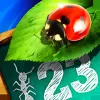Take a look inside 5 images
Bugs and Numbers
Pros: Beautiful graphics and a variety of skills covered.
Cons: Although kids get a bug when they master a skill, you can't track their progress.
Bottom Line: From matching and measurements to telling time and fractions, Bugs and Numbers covers more math skills than most apps.
Teachers can assign different games to different kids, depending on the skills each needs to practice, thus reaching a broad range of learners. You can set up separate accounts for multiple kids by going to Settings and finding Bugs and Numbers. Each kid's account will track which games they've mastered, but teachers won't be able to see which areas they may have struggled with.
Bugs and Numbers makes a bug's life for kids, as they explore math concepts such as matching, counting, sorting, sequencing, addition, subtraction, fractions, money, measurements, and telling time from the perspective of some realistic-looking critters. In three sections of six games each, bugs explore places like a diner, a junkyard, or a circus, and encounter skills in fitting backdrops. For fractions, ants deliver boxes of pizza to a picnic, and kids choose which fraction is represented in each box. Kids learn to count money in an arcade by dropping the correct amount into the machines. They earn bugs by completing each game and can zoom in to watch their bugs in action.
The variety of skills covered here is unusual for math apps -- kids can practice their numbers, count money, tell time, and develop an understanding of fractions all in one place. The graphics are incredibly realistic (beautiful, actually, if you agree that bugs are beautiful). And visual learning rules the day: for example, three bugs are on-screen when preschoolers are learning the numeral 3.
Incorrect answers are met with an, "Oops!" That answer disappears, and kids can answer again and again, with subsequent incorrect answers continuing to disappear, increasing their chances of finding the right one. Missed questions don't count toward the mastery goal, and, unfortunately, kids don't get an explanation or demonstration of correct answers.













